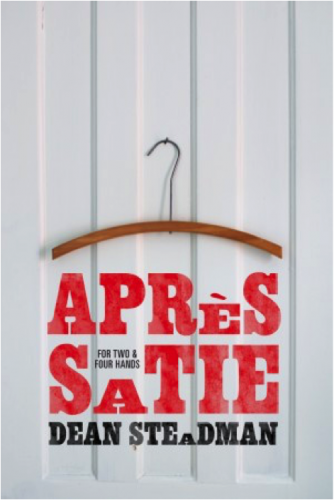Après Satie: For Two and Four Hands
by Dean Steadman
Brick Books (London, Ontario) 2016
I opened Dean Steadman’s collection hoping for something rich and flavourful, and I was not disappointed. Après Satie: For Two and Four Hands challenges and surprises, just as Satie’s composition did. Absurdism is a signature element of Erik Satie’s writing, and Steadman has listened to his mentor.
Why would Satie, who lived at the turn of the 20th century, be a mentor in this present era? Satie was responding to many different political and social pressures, all quite subtle and yet characteristic of his sensitivity. The same thing can be said about the times in which we find ourselves now, and Steadman has responded by throwing out lifelines of absurdism to distract us, but also to remind us that this has happened before – darkness and light, ugliness and beauty, love and hate.
In language reminiscent of a medieval nursery rhyme, Steadman rocks us, soothes us. “Backwards a goat to the Sabbat she rides, / To the Sabbat on a she-goat rides she. / Her leathery paps are wet with suckle, / The spewed suckle of the babe on her knee.” (“Spirit travel,” 71) Steadman invites us to chew and chew on sounds, so words take on an afterlife as symbols only: “Amaryllis belladonna, naked lady, shades of night, /The Sabbat frees the sacrifice of the properties of light.” (“Spirit travel,” 71)
Erik Satie had a tortured adolescence, was considered to be a lazy student, untalented. Still he persisted. His first real breakthrough came with the publication of his Gymnopédies. I was a 14-year-old piano student when the Gymnopédies found me. Simple and yet winsome, they suited my limited talents and lonely heart. I’ve loved Satie’s music ever since.
Steadman’s deft imaginings accompany Satie’s most famous and beloved pieces. He opens the collection with Theme and Vexations in which he alludes to Satie’s own vulnerability and heartbreak, “exposed without a tonal centre / …denying adieu, Bonjour Biqui, Bonjour!” (1). Biqui is the name Satie gave his great and only love, Suzanne Valadon. When their intense six-month long affair ended, Satie wrote Vexations, a miniature composition of a mere thirteen bars, but which he instructed must be repeated 840 times. Performers reported finding it a painful, exquisite, meditation on loss.
Music has power and Steadman’s poetic fables invoke the music. In Gymnopédie No. 1, he imagines a couple who meet at a train station, her bag is stolen, her only clothes hang in the closet during the entire weekend tryst, not needed until a piano playing on the radio brings a memory into the room and its accompanying sadness breaks the spell. All that remains is the woman’s “nakedness on the hanger where over the next week it faded away.” (24)
Après Satie is filled with delicious mouthfuls of vowels and consonants, fairy tale phrasing, and spicy turns which fully satisfy. Consider the prose poem En Habit de cheval. “A beautiful woman, with a figure so slight she could be carried on the wind…” She’s wooed by a young man who’s “a stallion in bed. His seed could sire champion show hunters.” Fricatives knock up against plosives and we feel the heat of this couple, the weight of their potential. Does the promise come to pass? Does the young stallion succeed? Not in Steadman’s world, where “her plan is to win the heart of a widower whose wispy white hair resembles the head of a late-summer dandelion nodding in the early evening breeze.” (7) The whispery image of the old man is a complete, yet tender contrast.
Satie was not a satirist, but he eschewed convention. His limitations became his strengths and his unusual traits created an aura of unexpected specialness that became attractive. Steadman captures this paradox in his lightness of tone combined with a grotesqueness of image. For a sample, try Sea Change. “The waves …channelling / some little salvage back / to the primal cunt of sanctuary / before the piracy of egg, / the plunder of womb.” (37) Or try Premier Menuet: “An Easter moon silenced her. Slit her tongue. Then her throat.” (70)
Descriptive details dance with fierce emotions until we’re swept up in a whirlwind, off balance, reaching out for something to grab onto and, thus, open to experience what it is that Steadman wants us to feel. In the dirge poem, Sunday visit, the mourning for a dying grandparent is given physical weight through absurdist images, “her heart a pounding waltz of bush elephants.” The family chattering in a “prevailing din of help and hospice,” likened to monkeys. The dying grandmother offering an explanation to a silent visitor, “Lumbering beasts, this herd.” “It’s our great ears, you see. Perfectly senseless.” (16)
Satie died without knowing his impact on history. Steadman’s Après Satie: For Two and Four Hands reminds us that there are only moments of choice, moments of living one day to the next, as they unfold. Readers will leave the world of Steadman’s surrealistic poems having experienced a pageantry that pays homage to a great man.
There is perhaps only distance after all,
or something remote and mathematical, in another day (111)










